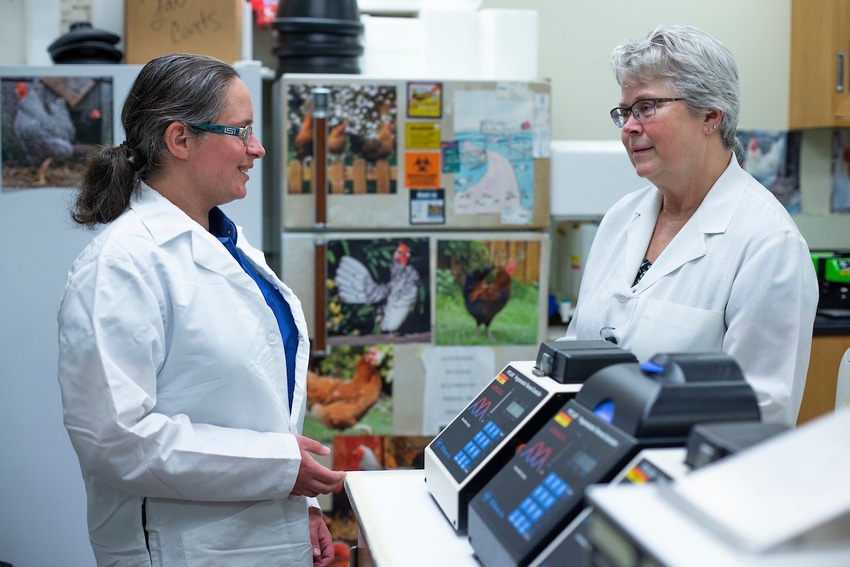Combining genotyping with novel statistical methods helps improve accuracy of breeding values.
May 15, 2019

Research applying advances in the field of genomics — the branch of molecular and statistical genetics concerned with identifying genetic variation and applying that knowledge — is transforming the poultry industry, thanks to scientists like Anna Wolc, an adjunct assistant professor in the Iowa State University department of animal science.
Since 2013, Wolc has had dual roles as an Iowa State faculty member and as a genomics geneticist for Hy-Line International, a Dallas Center, Iowa, company recognized as a world leader in poultry genetics.
“Traditional breeding takes generations to track results,” Wolc said. “Selection methods have long been based on observable characteristics — phenotypes — that can be seen and measured. For layers, these traits of interest would include the number of eggs laid, egg weight and quality and health-related traits like feather cover, survivability and disease resistance. My research looks at whether genomic information obtained from DNA genetic testing and analysis can better predict which birds will produce more and better-quality eggs,” she said. “We found we can use genomic information to identify the best birds faster to shorten the time it takes to see change.”
"Genomics is a new field for poultry science,” Hy-Line director of research and development Danny Lubritz said. “Anna is combining genotyping with novel statistical methods to improve the accuracy of breeding values and develop them in ways that are practical for the industry.
“As an example, we are dealing with sex-limited traits in the layer industry,” Lubritz explained. “Since males don’t lay eggs or contribute any data of their own, we rely on combining what we know of their genotypes with the observable phenotypes of their sisters. Anna is giving us modeling tools to more quickly and accurately predict which males have the best genetic potential.”
A research article by Wolc and her colleagues published in the Journal of Animal Science was recently recognized with an American Egg Board Research Award, presented by the Poultry Science Assn.
The research looked at dynamic stiffness -- an indicator of how much force is needed to crack an egg. The trait is important because higher numbers of broken eggs affect the economics for both producers and retailers, and cracked eggs pose food safety risks for consumers, Iowa State said.
“In part, egg quality, including dynamic stiffness, is a function of age,” Wolc said. “We were trying to learn if one test adequately predicts the quality of the eggs a hen will lay over its life or if you really need to test eggs at different ages. We found that you do need to test over time because a hen’s genetic potential for shell quality is expressed differently as she ages. This finding lays the groundwork for a new model of evaluating hens that should translate to better selection of future generations of birds with the genetic potential for improved shell quality.”
Wolc’s current research explores genetics related to poultry diseases such as avian influenza. “The disease caused a big disaster in 2015 when it killed vast numbers of birds in Iowa and elsewhere,” she said. “Typically, a few birds in affected flocks survive and remain healthy.”
She and her team obtained blood samples from survivors to search for genetic markers that could be linked to resistance to the disease.
“We’ve identified one gene that looks promising,” Wolc said. “Right now, we are cooperating with scientists at The Roslin Institute in Scotland to do laboratory testing to see if that candidate gene can keep the virus from entering the cell.”
“This research has huge implications for the future of egg production,” added Susan Lamont, interim director of the Egg Industry Center at Iowa State and a Charles F. Curtiss distinguished professor of agriculture and life sciences in the department of animal science. “It is really helping bring genomic technologies into animal improvement. Improving birds’ natural disease resistance has many benefits for the industry, for consumers and for animal welfare.”
Lamont is working with Wolc to research two other important poultry diseases, one caused by Escherichia coli and the other Newcastle disease virus.
Wolc is also collaborating on software development to improve breeding program design with Charles F. Curtiss distinguished professor Jack Dekkers and professor Rohan Fernando, both in animal science.
Source: Iowa State University, which is solely responsible for the information provided and is wholly owned by the source. Informa Business Media and all its subsidiaries are not responsible for any of the content contained in this information asset.
You May Also Like



